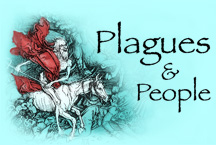
Infectious and Epidemic Disease in History
Department of History
University of California, Irvine
Instructor: Dr. Barbara J. Becker

Department of History
University of California, Irvine
Instructor: Dr. Barbara J. Becker
Supplementary readings for Week 7's lectures include excerpts
from:
In 1668, the English colony of New York was hit by an "autumnal bilious fever in its infectious form" which proved so fatal that the governor ordered a fast day. In 1693, it was Boston's turn. In 1699, the dread disease paid Charleston and Philadelphia what would be the first of many deadly visits over the next two centuries. In August 1793, Philadelphia fell victim once again. This time over 4000 died. Enlightened medical practitioners sought to identify the epidemic's cause. Many assumed contagion to be the chief mode by which the disease was transferred and advocated strict quarantine measures in all American ports to halt its spread. But a vocal group of equally eminent "anticontagionists" argued that filthy waterfronts were to blame. They reasoned that the bilious fever, also known "remitting," or "yellow" fever, only appears in those climates, seasons, and places in which heat -- acting on moist animal and vegetable matter -- produces putrid exhalations. They decried maritime quarantine as a futile and costly practice. Instead they recommended comprehensive city planning and extensive sanitation reform to eradicate the natural source of these epidemics.
|
 |
| Go to: |
|